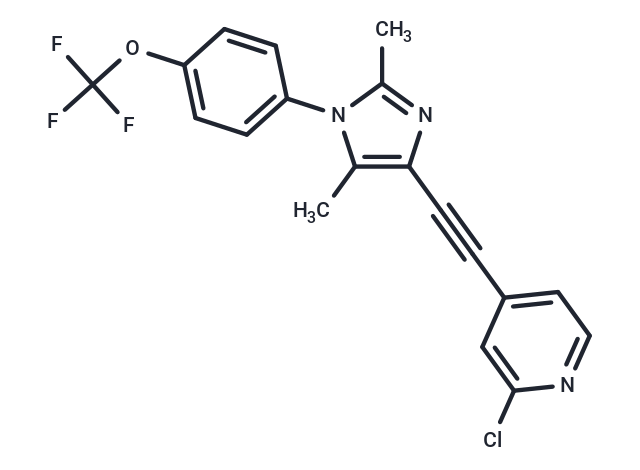Shopping Cart
- Remove All
 Your shopping cart is currently empty
Your shopping cart is currently empty

CTEP (RO 4956371) (RO4956371) is a novel, long-acting, orally bioavailable allosteric antagonist of mGlu5 receptor with IC50 of 2.2 nM, shows >1000-fold selectivity over other mGlu receptors.

| Pack Size | Price | Availability | Quantity |
|---|---|---|---|
| 2 mg | $31 | In Stock | |
| 5 mg | $48 | In Stock | |
| 10 mg | $85 | In Stock | |
| 25 mg | $148 | In Stock | |
| 50 mg | $270 | In Stock | |
| 100 mg | $367 | In Stock | |
| 200 mg | $522 | In Stock | |
| 1 mL x 10 mM (in DMSO) | $53 | In Stock |
| Description | CTEP (RO 4956371) (RO4956371) is a novel, long-acting, orally bioavailable allosteric antagonist of mGlu5 receptor with IC50 of 2.2 nM, shows >1000-fold selectivity over other mGlu receptors. |
| Targets&IC50 | mGlu5:2.2 nM |
| In vitro | CTEP inhibits quisqualate-induced Ca2+ mobilization with an IC50 of 11.4 nM and [3H]IP accumulation with an IC50 of 6.4 nM in HEK293 cells stably expressing human mGlu5. CTEP inhibits the constitutive activity of human mGlu5 by approximately 50% with an IC50 of 40.1 nM in HEK293 cells stably expressing human mGlu5. [1] |
| In vivo | CTEP exhibits significant efficacy at doses of 0.1 mg/kg and 0.3 mg/kg for treating anxiety in mice and enhances drinking behavior in the Vogel conflict drinking test at doses of 0.3 mg/kg and 1.0 mg/kg in rats, showing no effect at lower doses. The compound demonstrates an oral half-life of 18 hours, with a brain/plasma (B/P) ratio of 2.6 in mice, indicating its penetration and persistence in brain tissue. When administered orally to adult C57BL/6 mice as a microsuspension in saline/Tween, CTEP is rapidly absorbed, reaching near-maximal levels about 30 minutes post-dosing. Chronic dosing of 2 mg/kg orally every 48 hours for two months in adult mice ensures a minimal brain concentration of 240 ng/g. CTEP effectively displaces [3H]ABP688 from mGlu5 receptors in the mouse brain, with a 50% displacement achieved at an average brain concentration of 77.5 ng/g. At a regimen of 2 mg/kg orally twice daily, CTEP maintains continuous mGlu5 receptor engagement over 48 hours. Additionally, CTEP treatment at 2 mg/kg orally corrects hippocampal dysfunction, excessive protein synthesis, and audiogenic seizures in Fmr1 knockout mice, showcasing its potential in addressing a range of neurological conditions. |
| Kinase Assay | For all filtration radioligand binding assays, membrane preparations expressing the target receptors or receptor combinations are resuspended in radioligand binding buffer (15 mM Tris-HCl, 120 mM NaCl, 5 mM KCl, 1.25 mM CaCl2, and 1.25 mM MgCl2, pH 7.4), and the membrane suspension is mixed with the appropriate concentrations of radioligand and nonlabeled drugs in 96-well plates in a total volume of 200 μL and incubated for 60 min at the appropriate temperature. At the end of the incubation, membranes are filtered onto Whatman Unifilter preincubated with 0.1% polyethyleneimine in ish buffer (50 mM Tris-HCl, pH 7.4) with a Filtermate 196 harvester and washed three times with ice-cold ish buffer. Radioactivity captured on the filter is quantified on a Topcount microplate scintillation counter with quenching correction after the addition of 45 μL of MicroScint 40 per well and shaking for 20 min. The concentration of membranes and incubation time is determined for each assay in pilot experiments. |
| Alias | RO 4956371, mGluR5 inhibitor |
| Molecular Weight | 391.77 |
| Formula | C19H13ClF3N3O |
| Cas No. | 871362-31-1 |
| Smiles | Cc1nc(C#Cc2ccnc(Cl)c2)c(C)n1-c1ccc(OC(F)(F)F)cc1 |
| Relative Density. | 1.30 g/cm3 (Predicted) |
| Storage | Powder: -20°C for 3 years | In solvent: -80°C for 1 year | Shipping with blue ice. | ||||||||||||||||||||||||||||||||||||||||
| Solubility Information | H2O: < 1 mg/mL (insoluble or slightly soluble) Ethanol: 10 mg/mL (25.53 mM), Sonication is recommended. DMSO: 65 mg/mL (165.91 mM), Sonication is recommended. | ||||||||||||||||||||||||||||||||||||||||
Solution Preparation Table | |||||||||||||||||||||||||||||||||||||||||
Ethanol/DMSO
DMSO
| |||||||||||||||||||||||||||||||||||||||||

Copyright © 2015-2025 TargetMol Chemicals Inc. All Rights Reserved.